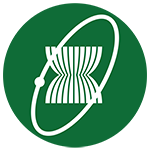CT APPEARANCE OF AMOEBIC AND PYOGENIC LIVER ABSCESSES
Abstract
OBJECTIVE. A retrospective review was performed to compare CT appearance of amoebic and pyogenic liver abscesses.
MATERIAL AND METHODS. Fifteen patients of proven amoebic or pyogenic liver abscess, which underwent CT scan, were retrospectively reviewed. The CT appearance was analyzed for number, location, size, shape, central homogeneity, central attenuation coefficient, rim enhancement, peripheral low-attenuation rim, and the presence of extrahepatic manifestations.
RESULTS. There were five cases of amoebic liver abscesses. All amoebic liver abscesses were solitary hypoattenuating mass with rim enhancement and all were in the right lobe. Four patients of amoebic abscess showed "double target sign". There were nine cases of pyogenic liver abscesses. Pyogenic liver abscesses could be located in any lobe and mostly appeared as cluster of microabscesses or a macroabscess with adjacent microabscesses. Pyogenic abscess could appear as miliary abscesses, solitary macroabscess or multiple separated macroabscesses. One patient of proven mixed amoebic and pyogenic abscesses showed ten separated abscesses scattering in both lobes of the liver.
CONCLUSION. Amoebic liver abscess was mostly in the right lobe and appeared as a solitary hypoattenuating mass with rim enhancement. The CT appearance of pyogenic liver abscesses were variable and mostly showed "cluster sign".
Downloads
Metrics
References
VanSonnenburg E, Mueller PR, SchiffmanHR, et al. Intrahepatic amoebic abscesses: indications for and results of percutaneous catheter drainage. Radiology 1985; 156: 631-635.
Samuelson J, Von Lichtenberg F. Infectious disease. In: Cotran RS, Kumar V, Robbins SL, eds. Pathologic basis of disease. 5th ed. Philadelphia, Pa: Saunders, 1994; 305-377.
Eckburg PB, Montoya JG. Hepatobiliary infection. IN: Wilson WR, Sande MA, eds. Diagnosis and treatment in infectious disease: Lange current series. New York, NY: McGraw-Hill, 2001; 269-286.
Mortele KJ, Segatto E, Ros PR. The infected liver: Radiologic-pathologic correlation. Radiographic 2004; 24(4): 937-955.
Ralls PW. Focal inflammatory disease of the liver. Radiologic clinics of North America 1998; 36(2): 377-389.
Radin DR, Ralls PW, Colletti PM, Halls JM. CT of amoebic liver abscess. AJR Am J Roentgenol 1988;150:1297-1301.
Hagga JR, Lanzieri CF, Sartoris DJ, Zerhouni EA. CT and MRI of the whole body, 3rd ed. St.Louis, Missouri: Mosby, 1994; 896-944.
Mathieu D, Vasile N, Fagniez PL, Segui S, Grably D, Larde D. Dynamic CT features of hepatic abscesses. Radiology 1985; 154:749-752.
Lee JKT, Sagel SS, Stanley RJ, Heiken JP. Computed body tomography with MRI correlation. 3rd ed. Philadelphia: Lippincott-Raven, 1998; 701-777.
Pitt HA. Liver abscess. In:Turcotte JG, ed. Shackelford's surgery of the alimentary tract, 3rd ed. Philadelphia: WB Saunders, 1991; 443-465.
Land MA, Moinuden M, Biano AL. Pyogenic abscess: changing epidemiology and prognosis. South Med J 1985;78: 1426-1430.
Jeffrey RB Jr, Tolentino CS, Chang FC, Fedrle MP. CT of pyogenic hepatic microabscesses: The cluster sign. AJR Am J Roentgenol 1988; 151; 487-489.
Halvorsen RA, Korobkin M, Foster WL, et al. The variable CT appearance of hepatic abscesses. AJR Am J Roentgenol 1984; 141: 941-946.
Moretele KJ, Ros PR. Cystic focal liver lesions in the adults : Differential CT and MR imaging features. Radiographic 2001; 21: 895-910.
Brancatelli G, Federle MP, Vilgrain V, Vullierme MP, Marin D, Lagalla R. Fibropolycystic liver disease: CT and MR imaging findings. Radiographic 2005; 25: 659-670.
Downloads
Published
How to Cite
Issue
Section
License
Copyright (c) 2023 The ASEAN Journal of Radiology

This work is licensed under a Creative Commons Attribution-NonCommercial-NoDerivatives 4.0 International License.
Disclosure Forms and Copyright Agreements
All authors listed on the manuscript must complete both the electronic copyright agreement. (in the case of acceptance)













